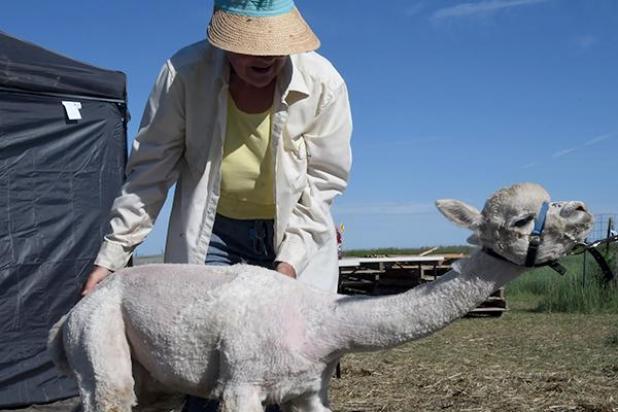
Carol Fleshman helps one of her alpacas back to its pen. It’s not easy to move alpacas, especially on shearing day. After doing this once every year, however, Fleshman is used to the push and pull of her herd. — The Holyoke Enterprise | Johnson Publications
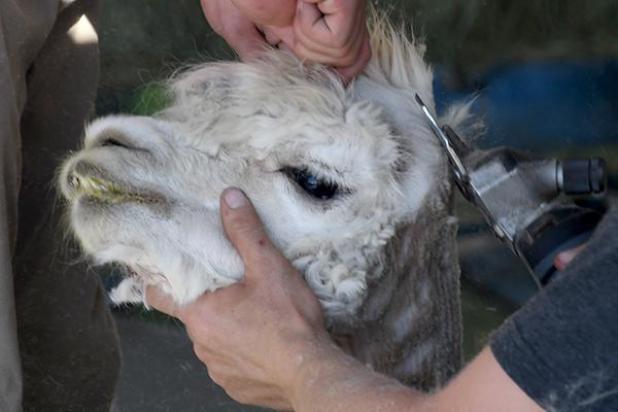
Top Knot Shearing Company lays the alpaca down gently before starting on the process where they begin to shear the head of one of Fleshman’s many alpacas. — The Holyoke Enterprise | Johnson Publications
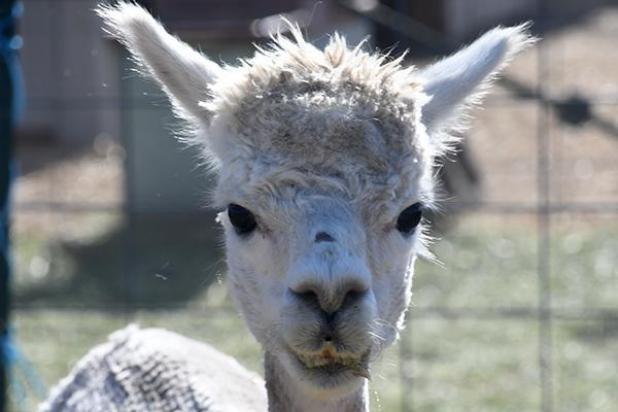
An alpaca in Fleshman’s herd looks out toward the volunteers after it has been shaved. — The Holyoke Enterprise | Johnson Publications
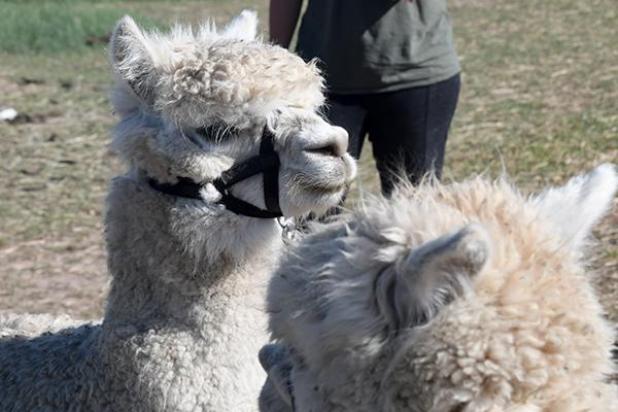
Two of Fleshman’s alpacas wait patiently for their turn with the shearer. Fleshman shears her alpacas every summer to help them combat the heat. — The Holyoke Enterprise | Johnson Publications
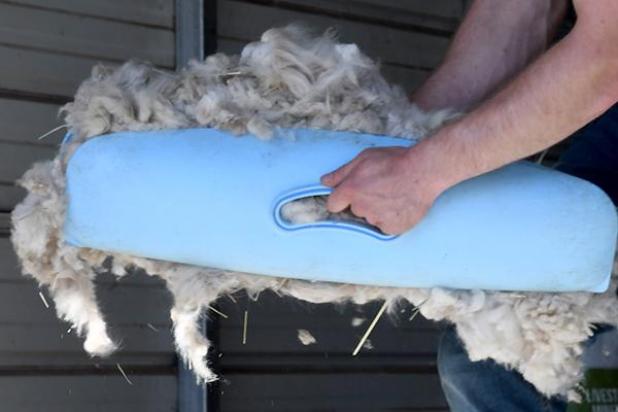
A crew member of Top Knot Shearing gathers the fleece of an alpaca after it has been sheared. — The Holyoke Enterprise | Johnson Publications
Tug-of-war
In the blistering heat of the summer, Carol Fleshman and a crew of nine people sheared 50 alpacas. Although all of the human volunteers were sweating under the hot sun, the animals on the farm were getting cool.
While one alpaca would be losing 5-7 pounds of fleece after their shearing, Macey and Bandit, two of the dogs on the farm, were having fun chasing the newly sheared alpacas back into their pens.
“I think to them, she’s just an ugly alpaca,” Fleshman said about Macey, her dog.
What started at 7:30 in the morning on Monday, June 7, went well into the afternoon to make sure that every alpaca was cleanly sheared.
Top Knot Shearing, the company Fleshman hired to help, had three crew members working alongside Fleshman’s family and local volunteers which made the process go faster. Creating an assembly line in front of the makeshift shearing shed created enough jobs for everyone to do.
However, it was not easy to have the alpacas go to the shearer voluntarily. Many crew members had to get down on their hands and knees onto the rocky ground to try and grab hold of an alpaca’s back legs to lift them up so they could walk. One volunteer had to hold onto the entire back of an alpaca so it would walk back into its pen.
Many alpacas started to fight against the harnesses put around their faces, which started a battle of tug-of-war between the alpaca and the crew. Ashley Sullivan, Holyoke Enterprise office manager, had her fair share of battles that morning. One of the alpacas that was in her grasp slowly went behind her so that she could not fully see it in her peripheral vision. After the alpaca thought that the coast was clear, it tried to break free of Sullivan’s grasp. Luckily, she was faster than the alpaca and kept it in place.
Between alpacas trying to run away, and some who laid on the ground not wanting to move, it seemed that shearing all of the alpacas would take forever. Fleshman said that although it might have felt that way, they ended the day around 4 p.m. with all 50 alpacas sheared.
With the help of the local volunteers and the crew members of Top Knot Shearing, the longest day of the year on Fleshman’s farm came to a close.
Learning how to shear an alpaca
The first step to shearing an alpaca is to catch it. After harnessing an alpaca, it might still be difficult to bring it all the way to the shearing shed.
Many of the alpacas in Monday’s shearing party flopped their entire bodies on the ground and would not move no matter how hard they were budged. Much like a dog getting its toenails clipped, the alpacas on Fleshman’s farm acted like they were moving toward a butcher block rather than to get sheared.
Second, the alpacas were put on their sides, which was easier if they were the aforementioned ones who flopped on the ground. After they were secured on a soft cushioned mat that Top Knot provided, the shearing crew then tied the alpaca’s front and back feet together and stretched them so they could shear easier.
The crew began shearing the upside of the alpaca first and then rotated toward their stomach, loosening the ties on the feet as they went.
Other amenities they can provide for the alpacas are to clip their toenails and grind down their teeth if needed.
Fleshman warned the crew before starting the process that the alpacas are not afraid to spit on you.
Afterward, Fleshman was left with around 250 to 270 pounds of fleece that she will begin skirting.
Skirting is the process of removing all of the debris out of the fleece, which could be hay, sticks and even dried mud.
“Alpacas are like dogs. They like to roll in the dirt,” Fleshman said.
Since the fleece can be so fine, and you would want to preserve the waves inside of the fleece, you have to skirt by hand.
Even though the alpacas’ jobs are done, Fleshman’s has just begun.
As soon as she is finished skirting through all of the fleece, which could take her days, Fleshman will then send the fleece to a mill to be processed into whatever she desires.
Sweaters, yarn, socks and even dryer balls are items Fleshman could create with her processed fleece. Her next step, however, is to find someone who will help her get into contact with other people who are looking for American processed fleece.
Following the life of the alpaca lady
Although she is not a native to Holyoke, Fleshman has acquired the name “the alpaca lady” around town. She grew up in Ogallala, Nebraska. After receiving her degree from the University of Nebraska and living in Lincoln, Nebraska, for 13 years, she moved to Golden to become a deputy. She served as one of the six female officers in Golden for over 29 years before retiring seven years ago.
Starting her alpaca herd 12 years ago made Fleshman realize that when she retired, she would need to find a space big enough for both herself and her animals.
Fleshman decided to buy a 5-acre plot of land 8 miles north of Holyoke that she has turned into her own fiber farm.
When she did live in Golden, Fleshman said she felt isolated within their communities. Here in Holyoke, it is the complete opposite.
“I don’t think they knew what to think of me at first, because it’s like ‘What does she have? What? Llamas? Alpacas?’ You know, they might not know my name or anything about me, but they know, here, what I do,” she said.
Wanting to be more involved in the community, Fleshman has joined many groups in town.
She belongs to Zion Lutheran Church and is an officer for the women’s group at her church. Additionally, she is a member of the Friends of the Library, was involved for a while on the county historical society board and volunteers wherever and whenever she can.
Fleshman has even found ways to help her neighboring farmers. After a farmer who also owned alpacas became sick, Fleshman took it upon herself to help raise his herd along with her own 27-alpaca herd at the time. Now owning over 50 alpacas, she does not see herself having any more.
What started out as having cute animals has turned into a business for Fleshman after retirement, and something to look forward to. Although, she dislikes their spit as much as the next guy.
